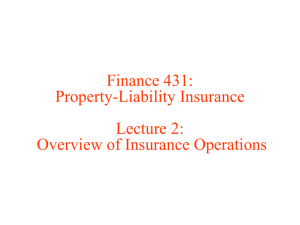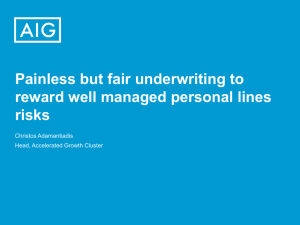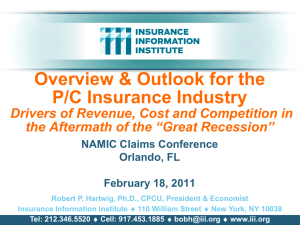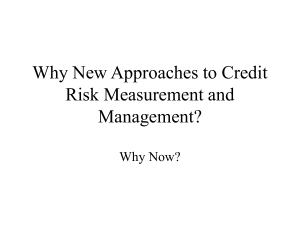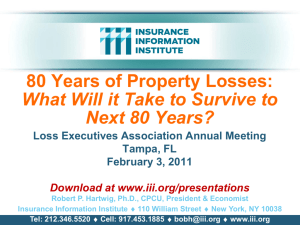CLM-032411 - Insurance Information Institute
advertisement
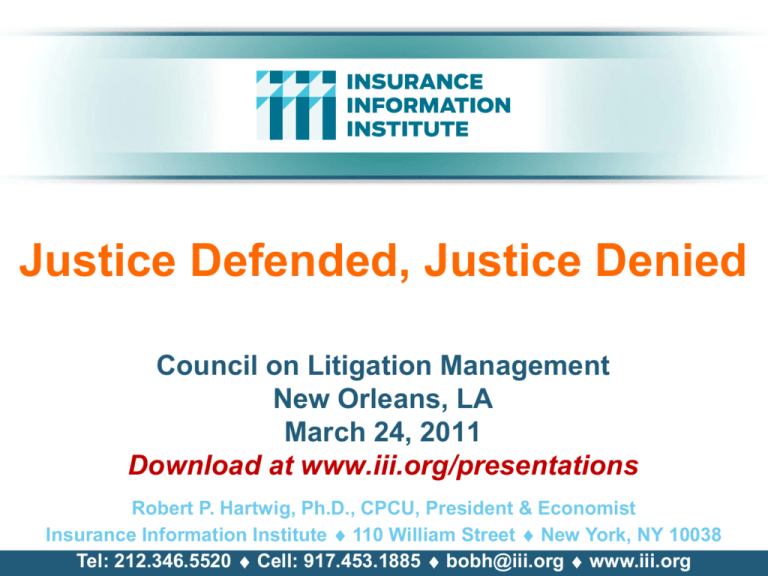
Justice Defended, Justice Denied Council on Litigation Management New Orleans, LA March 24, 2011 Download at www.iii.org/presentations Robert P. Hartwig, Ph.D., CPCU, President & Economist Insurance Information Institute 110 William Street New York, NY 10038 Tel: 212.346.5520 Cell: 917.453.1885 bobh@iii.org www.iii.org Presentation Outline Insurers Have Paid Trillions and Trillions on Millions and Millions of Claims Inconsistent with Thesis of Delay, Deny, Defend The Dollars and Sense of Claim Payments Claims Operations as a Profit Center? Assertion is Unsupported by the Facts What is Really Happening to P/C Insurer Profitability? Insurance Ratemaking 101: The (Solved) Mystery of the Falling Loss Ratio Claims Management Software An absolute necessity in an era of rapidly rising medical costs and rampant fraud and abuse No place for nostalgia A Case Study: Catastrophe Losses Insurance is the fastest, most reliable means of recovery after disasters, large and small Fraud: It’s Real, It’s Expensive (i.e., It’s Really Expensive) DDD Asserts: Fraud = “Social Marketing” and is “Exaggerated” 2 The Central Thesis of “Delay, Deny, Defend” Is Unsupported by the Facts THE FACTS: The P/C Insurance Industry Pays Millions of Claims Totaling $1 Trillion in Claims Every 2-3 Years 3 With $12.6 Trillion of Paid Claims, Thesis Of a Book Like This Has to Be Challenged Delay, Deny, Defend makes broad assertions based largely on anecdote and dated information. A more comprehensive and analytical approach debunks the book’s central thesis that insurers seek to profit by squeezing consumers out the claims dollars that are due to them. 4 Dollar Value of Claims Paid by P/C Insurers to Policyholders, 1925–2010E* $ Billions Claim payouts in recent years are volatile but have reached a jagged plateau Since 1925, P/C insurers have paid more than $7.2 trillion in claims to policyholders ($12.6 trillion in 2010 dollars) $400 $350 $300 $250 $200 Claim payouts increased exponentially for decades $150 $100 Catastrophe losses, underwriting cycle contribute to volatility; Prolonged soft market, recession to plateau $50 *1925 – 1934 stock companies only. Includes workers compensation state funds 1998-2006. Note: Data are not adjusted for inflation. Sources: Insurance Information Institute research and calculations from A.M. Best data. 2010E *2005 *2000 1995 1990 1985 1980 1975 1970 1965 1960 1955 1950 1945 1940 1935 1930 1925 $0 5 Cumulative Value of Claims Paid by P/C Insurers to Policyholders, 1925–2010E* $ Billions It took 60 years for the industry to pay its first $1 trillion in claims in the years since 1925. Today, the industry pays $1 trillion in claims every 3 to 4 years. $8,000 $7,000 $6,000 $5,000 4 years (2010) 3 years (2006) 3 years (2003) 5 years (2000) $4,000 4 years (1995) $3,000 7 years (1991) $2,000 60 years (1925 – 1984) $1,000 *1925 – 1934 stock companies only. Includes workers compensation state funds 1998-2006. Note: Data are not adjusted for inflation. Sources: Insurance Information Institute research and calculations from A.M. Best data. 2010E *2005 *2000 1995 1990 1985 1980 1975 1970 1965 1960 1955 1950 1945 1940 1935 1930 1925 $0 6 Inflation-Adjusted Dollar Value of Claims Paid by P/C Insurers, 1925–2010E* $ Billions $400 $350 $300 Since 1925, P/C insurers have paid more than $12.6 trillion in claims to policyholders on an inflation-adjusted basis $250 $200 Claim payouts increased exponentially for decades, but more erratically in the post-1980 era $150 $100 On an inflation-adjusted basis, claims paid have fallen to 1990s levels, reflecting improved underwriting results, exposure loss during the “Great Recession” and leakage to alternative markets $50 *1925 – 1934 stock companies only. Includes workers compensation state funds 1998-2006. Sources: Insurance Information Institute research and calculations from A.M. Best data. 2010E 2005 2000 1995 1990 1985 1980 1975 1970 1965 1960 1955 1950 1945 1940 1935 1930 1925 $0 7 Cumulative Value of Inflation-Adjusted Claims Paid by P/C Insurers, 1925–2010E* Adjusted for inflation, it took 36 years for the industry to pay its first $1 trillion in claims in the years since 1925. Today, the industry pays $1 trillion in claims every 2 to 3 years after adjusting for inflation. $ Billions $14,000 $13,000 $12,000 $11,000 $10,000 $9,000 $8,000 $7,000 $6,000 $5,000 $4,000 $3,000 $2,000 $1,000 $0 3 years (2008) 3 years (2005) 2 years (2002) 4 years (2000) 3 years (1996) 3 years (1993) 4 years (1990) 4 years (1986) 5 years (1982) 7 years (1977) 9 years (1970) *1925 – 1934 stock companies only. Includes workers compensation state funds 1998-2006. Sources: Insurance Information Institute research and calculations from A.M. Best data. 2010E *2005 *2000 1995 1990 1985 1980 1975 1970 1965 1960 1955 1950 1945 1940 1935 1930 1925 36 years (1925 – 1961) 8 P/C Insurance Loss & LAE Ratio, 1920–2010E* Loss Ratio (%) Loss ratios were much lower prior to the early 1980s—even lower than today. DDD’s central thesis would seem to suggest that management in the pre-1992 (pre-McKinsey era) also viewed claims as a profit center (even more so)… 100 90 80 70 Prof. Feinman uses the late 1980s as a starting point for his data, causing a statistical bias used to corroborate his thesis. Including a longer time series would disprove DDD’s thesis. DDD asserts that the drop in loss ratios since the mid-1980s is proof that insurers are squeezing claimants in their effort turn their claims operations into profits centers 60 50 *1920 – 1934 stock companies only. Includes workers compensation state funds 1998-2006. Sources: Insurance Information Institute research and calculations from A.M. Best data. 2010E *2005 *2000 1995 1990 1985 1980 1975 1970 1965 1960 1955 1950 1945 1940 1935 1930 1925 1920 40 9 Loss and LAE Ratio: 1920s – 2000s Loss + LAE Ratio 85 80 75 70 Loss + LAE ratios are actually quite high today compared to the 90-year average of 66.9 between 1920-2010. 65 60 79.8 75.8 71.8 67.4 60.2 57.8 52.8 55 81.0 The Loss + LAE ratio is actually higher today than it was when interest rates were at similar levels in the 1960s 54.7 50 45 40 1920s 1930s 1940s 1950s 1960s 1970s 1980s 1990s 2000s There is a Clear, Consistent Relationship Between Loss Ratios and Investment Yield Over the Span of Decades. Lower Loss Ratios in the 2000s Relative to the 1980s and 1990s Reflect the Reality of Investment Yields Sources: A.M. Best, Board of Governors of the Federal Reserve; Insurance Information Institute. Loss and LAE Ratio vs. 10-Year Treasury Yield, 1962-2010 As yields have trended downward, so too have loss ratios, since a smaller proportion of losses can be covered by investment earnings (%) 95 Loss and LAE Ratio 90 (%) 14 10-Year Treasury Yield 12 80 10 75 8 70 6 65 4 60 Higher yields support higher loss ratios, since a higher proportion of losses can be covered by investment earnings 55 10-Year Treasury Yield 85 Loss & LAE Ratio 16 2 50 0 62 65 68 71 74 77 80 83 86 89 92 95 98 01 Sources: A.M. Best, Board of Governors of the Federal Reserve; Insurance Information Institute. 04 07 10E 11 Loss and LAE Ratio vs. 10-Year Treasury Yield, by Decade: 1960s – 2000s Loss + LAE Ratio 85 81.0 The Loss + LAE ratio is actually 10-Yr. higher today than it was when Treasury Yield interest rates were at similar 18% levels in the 1960s 79.8 15% 80 75.8 75 70 65 71.8 67.4 12% 9% 10.6% 6% 7.5% 6.7% 4.8% 4.6% 60 3% 0% 1960s 1970s 1980s Loss & LAE Ratio 1990s 2000s* 10-Year Treasury Yield There is a Clear, Consistent Relationship Between Loss Ratios and Investment Yield Over the Span of Decades. Lower Loss Ratios in the 2000s Relative to the 1980s and 1990s Reflect the Reality of Investment Yields Sources: A.M. Best, Board of Governors of the Federal Reserve; Insurance Information Institute. Underwriting Gain (Loss) 1975–2010:Q3* ($ Billions) $35 $25 $15 After interest rates began to rise in the late 1970s, insurers began to run large underwriting losses (implying a high loss ratio), offsetting those losses with investment earnings $5 -$5 -$15 -$25 In an era of low interest rates, insurers need to operate with lower underwriting losses or with an underwriting profit -$35 -$45 -$55 75 77 79 81 83 85 87 89 91 93 95 97 99 01 03 Large Underwriting Losses Are NOT Sustainable in Current Investment Environment * Includes mortgage and financial guarantee insurers. Sources: A.M. Best, ISO; Insurance Information Institute. 05 07 09 Number of Years with Underwriting Profits by Decade, 1920s–2000s Number of Years with Underwriting Profits Insurers ran underwriting profits consistently prior to the 1980s. Therefore, loss ratios then were, on average, lower than today. 12 10 10 8 8 7 6 6 5 4 4 3 2 0 0 1980s 1990s 0 1920s 1930s 1940s 1950s 1960s 1970s 2000s* Underwriting Profits Were Common Before the 1980s (40 of the 60 Years Before 1980 Had Combined Ratios Below 100) – But Then They Vanished. Not a Single Underwriting Profit Was Recorded in the 25 Years from 1979 Through 2003 * 2000 through 2009. 2009 combined ratio excluding mortgage and financial guaranty insurers was 99.3, which would bring the 2000s total to 4 years with an underwriting profit. Note: Data for 1920–1934 based on stock companies only. Sources: Insurance Information Institute research from A.M. Best Data. 14 Empirical Evidence that the Central Thesis of “Delay, Deny, Defend” Is Wrong No Evidence that Claims Practices Are Anything Other Than Fair; Certainly Not Used as a Profit Center 15 P/C Pure Loss Ratios, 1989-2008 P/C industry, pure loss ratio, 1989-2008 DDD’s thesis would suggest that falling loss ratios support the assertion of insurers squeezing claimants to raise profits 80 70 60 50 1985 If the thesis is true, then ROEs should be steadily increasing. What does the evidence say? 1990 1995 2000 2005 2010 Data source: Best’s Aggregates & Averages – Property/Casualty 16 Source: Council on Litigation Management presentation by Jay Feinman, March 24, 2011, from A.M. Best data. 16 ROE: Property/Casualty Insurance, 1987–2010E* (Percent) P/C Profitability Is Both by Cyclicality and Ordinary Volatile 20% Katrina, Rita, Wilma 15% 10% Sept. 11 Hugo 5% Andrew 0% 4 Hurricanes Lowest CAT Losses in 15 Years Northridge Financial Crisis* -5% 87 88 89 90 91 92 93 94 95 96 97 98 99 00 01 02 03 * Excludes Mortgage & Financial Guarantee in 2008 - 2010. Sources: ISO, Fortune; Insurance Information Institute figure for 2010 is actual through 2010:Q3. 04 05 06 07 08 09 10E 17 ROE vs. Equity Cost of Capital: U.S. P/C Insurance:1991-2010:9-Months* (Percent) 18% 16% 6% 4% 2% 0% -9.0 pts -13.2 pts 8% +1.7 pts 10% -3.2 pts 12% -6.4 pts +2.3 pts 14% -2.7 pts The P/C Insurance Industry Fell Well Short of Its Cost of Capital in 2008 but Narrowed the Gap in 2009 and 2010 The Cost of Capital is the Rate of Return Insurers Need to Attract and Retain Capital to the Business US P/C Insurers Missed Their Cost of Capital by an Average 6.7 Points from 1991 to 2002, but on Target or Better 2003-07, Fell Short in 2008-2010 -2% 91 92 93 94 95 96 97 98 99 ROE 00 01 02 03 04 05 06 07 08* 09* 10* Cost of Capital * Return on average surplus in 2008-2010 excluding mortgage and financial guaranty insurers. Source: The Geneva Association, Insurance Information Institute 18 A 100 Combined Ratio Isn’t What It Once Was: Investment Impact on ROEs A combined ratio of about 100 generated ~7.5% ROE in 2009/10, 10% in 2005 and 16% in 1979 Combined Ratio / ROE 110 105 15.9% 14.3% 100.6 100 100.1 97.5 100.7 12.7% 15% 101.0 99.5 99.7 7.3% 7.7% 9.6% 95 18% 92.6 12% 9% 8.9% 6% 90 4.4% 85 3% 0% 80 1978 1979 2003 2005 Combined Ratio 2006 2008* 2009* 2010:Q3* ROE* Combined Ratios Must Be Lower in Today’s Depressed Investment Environment to Generate Risk Appropriate ROEs * 2009 and 2010:Q3 figures are return on average statutory surplus. 2008, 2009 and 2010:H1figures exclude mortgage and financial guaranty insurers Source: Insurance Information Institute from A.M. Best and ISO data. P/C Profitability Components Are Highly Variable But ROE Is Not Trending Upward Smaller Underwriting Losses Falling Investment Yield All of the components of P/C insurer profits are highly volatile, but net investment yield shows a steady downward trend. The ONLY way to counter this is to reduce underwriting losses, the magnitude of which has been shrinking in recent years. Delay, Deny, Deny inappropriately and inaccurately ascribes this as evidence of an effort deprive policyholders out of what is due them. 20 US Policyholder Surplus: 1975–2010* ($ Billions) Surplus as of 6/30/10 was a near-record $530.5B, up from $437.1B at the crisis trough at 3/31/09. Prior peak was $521.8 as of 9/30/07. Surplus as of 6/30/10 is now 1.7% above 2007 peak; Crisis trough was as of 3/31/0916.2% below 2007 peak. $600 $550 $500 $450 $400 $350 $300 $250 “Surplus” is a measure of underwriting capacity. It is analogous to “Owners Equity” or “Net Worth” in non-insurance organizations $200 $150 $100 $50 $0 75 77 79 81 83 85 87 89 91 93 95 97 * As of 6/30/10; **Calculated using annualized net premiums written based on H1 2010 data. Source: A.M. Best, ISO, Insurance Information Institute. 99 01 03 05 07 09 Claims Management Software Assertion that Use of Software Results in a Systematic Bias Against Claimants is False 22 Claims Management Software Claims Management Software (such as Colossus) is Used to Increase Consistency and Reduce Subjectivity in the Claims Evaluation Process (CSC) Sophisticated processes are necessary to ensure consistent and fair payments to millions of claims involving tens of billions in cost each year The use of computer software is necessary to achieve this goal NY Insurance Department (Oct. 2010): “It is important to note that we found no systemic underpayment of bodily injury claims.” – Comments of NY Superintendent Wrynn following a recent carrier examination There is Nothing Nostalgic About the Era of 100% Manual Claims Adjusting in an Era of Rapid Medical Cost Inflation and Rampant Fraud and Abuse Without claims management software, overall system costs would be higher Incidence rate of fraud and abuse would be higher The Role of Technology in Claims Adjusting Will Evolve and Grow This transformational role of information is not unique to insurance 23 P/C Insurance Claim Cost Drivers Grow Faster than even the Medical CPI Suggests Price Changes in 2010 9% 8.8% 6% Excludes Food and Energy 6.1% 4.3% 3% 3.4% 3.3% 3.1% 1.6% 1.0% 0% Overall CPI "Core" CPI Medical CPI Inpatient Hospital Services Outpatient Hospital Services Physicians' Prescription Medical Care Services Drugs Commodities Keeping tabs on medical costs is an absolute imperative. Failure to do so would radically increase systems costs and premiums and reduce availability Source: Bureau of Labor Statistics; Insurance Information Institute. 24 Case Study: Catastrophe Losses Are Increasing in Number and Cost THE FACTS: The P/C Insurance Industry Pays Millions of Claims Totaling $1 Trillion in Claims Every 2-3 Years 25 US Insured Catastrophe Losses $9.2 $27.1 $27.5 $12.9 $5.9 $26.5 $4.6 $8.3 $10.1 $2.6 $7.4 $8.3 $16.9 $4.7 $2.7 $20 $7.5 $40 $5.5 $22.9 $60 $13.6 $80 First Half 2010 CAT Losses Were Down 19% or $1.4B from first half 2009 $61.9 2000s: A Decade of Disaster 2000s: $193B (up 117%) 1990s: $89B $10.6 $100 $6.7 $120 $100.0 $100 Billion CAT Year is Coming Eventually ($ Billions) $0 89 90 91 92 93 94 95 96 97 98 99 00 01 02 03 04 05 06 07 08 09 10*20?? CAT Losses in the Future are Guaranteed to Rise *Estimate from Munich Re. Note: 2001 figure includes $20.3B for 9/11 losses reported through 12/31/01. Includes only business and personal property claims, business interruption and auto claims. Non-prop/BI losses = $12.2B. Sources: Property Claims Service/ISO; Munich Re; Insurance Information Institute. 26 Combined Ratio Points Associated with Catastrophe Losses: 1960 – 2010E Combined Ratio Points 8.1 8.8 2.6 3.3 2010E 1.6 2.7 2008 2002 2006 1.6 2004 1.6 2000 3.3 3.3 3.6 2.9 1.0 1998 1996 1994 5.0 5.4 5.9 3.3 2.8 2.3 2.1 1990 1992 1.2 1988 1986 1984 1982 1980 1978 1976 1974 1972 1970 1.2 0.4 0.8 1.3 0.3 0.4 0.7 1.5 1.0 0.4 0.4 0.7 1.8 1.1 0.6 1.4 2.0 1.3 2.0 0.5 0.5 0.7 1968 0.4 1966 1962 1964 3.0 3.6 1960s: 1.04 1970s: 0.85 1980s: 1.31 1990s: 3.39 2000s: 3.52 0.8 1.1 1.1 0.1 0.9 1960 10 9 8 7 6 5 4 3 2 1 0 Avg. CAT Loss Component of the Combined Ratio by Decade The Catastrophe Loss Component of Private Insurer Losses Has Increased Sharply in Recent Decades Notes: Private carrier losses only. Excludes loss adjustment expenses and reinsurance reinstatement premiums. Figures are adjusted for losses ultimately paid by foreign insurers and reinsurers. Source: ISO; Insurance Information Institute estimate for 2010. 27 Natural Disasters in the United States, 1980 – 2010 Number of Events (Annual Totals 1980 – 2010) Number There were a record 247 natural disaster events in the US in 2010 Geophysical (earthquake, tsunami, volcanic activity) Source: MR NatCatSERVICE Meteorological (storm) Hydrological (flood, mass movement) Climatological (temperature extremes, drought, wildfire) 28 Recent Major Global Catastrophe Losses (Insured Losses, $US Billions) $30 $25 $20 The March 2011 earthquake in Japan will become among the most expensive in world history in terms of insured losses (current leader is the 1994 Northridge earthquake with $22.5B in insured losses in 2010 dollars) $25.0 $15 $8.0 $10 $10.0 $5.0 $5 $0.5 $2.0 $0 Cyclone Yasi (Australia) Feb 2011 Australia Floods New Zealand Chile Earthquake New Zealand Japan Earthquake (Dec - Feb 2011) Quake (Sep 2010) (Feb 2010) Quake (Feb 2011) (Mar 2011)* Insured Losses from Recent Major Catastrophe Events Exceed $50 Billion, an Estimated $48 Billion of that from Earthquakes *Midpoint of AIR Worldwide estimated insured loss range of $15 billion to $35 billion as of March 13, 2011. Does not include tsunami losses. Sources: Insurance Council of Australia, Munich Re, AIR Worldwide; Insurance Information Institute. 29 Top 12 Most Costly Disasters in US History (Insured Losses, 2009, $ Billions) $50 $45 $40 $35 $30 $25 $20 $15 $10 $5 $0 Hurricane Katrina Remains, By Far, the Most Expensive Insurance Event in US and World History $45.1 $22.2 $22.7 $11.3 $12.6 Wilma (2005) Ike Northridge Andrew (2008) (1994) (1992) 9/11 Attacks (2001) $17.2 $4.2 $5.2 Jeanne Frances (2004) (2004) $6.2 $6.6 $8.1 $8.5 Rita (2005) Hugo (1989) Ivan (2004) Charley (2004) Katrina (2005) 8 of the 12 Most Expensive Disasters in US History Have Occurred Since 2004; 8 of the Top 12 Disasters Affected FL Sources: PCS; Insurance Information Institute inflation adjustments. 30 Total Value of Insured Coastal Exposure (2007, $ Billions) Florida $2,458.6 New York $2,378.9 $895.1 Texas Massachusetts $772.8 New Jersey $635.5 Connecticut $479.9 Louisiana $224.4 S. Carolina $191.9 Virginia $158.8 Maine $146.9 In 2007, Florida Still Ranked as the #1 Most North Carolina $132.8 Exposed State to Hurricane Loss, with $92.5 Alabama $2.459 Trillion Exposure, but Texas is very exposed Georgia $85.6 too, and ranked #3 with $895B Delaware $60.6 in insured coastal exposure New Hampshire $55.7 Mississippi $51.8 The Insured Value of All Coastal Property Was $8.9 Rhode Island $54.1 Trillion in 2007, Up 24% from $7.2 Trillion in 2004 Maryland $14.9 $0 Source: AIR Worldwide $500 $1,000 $1,500 $2,000 $2,500 $3,000 31 Global Catastrophe Loss Trends Claims Paying Capacity Will Need to Increase in the Future if Current Disaster Trends Continue 32 Natural Catastrophes Worldwide, 1980 – 2010 (Number of events with trend) Number Increased claims paying capacity will be required on a global scale if current trends continue (as is expected) 1 200 1 000 800 600 400 200 1980 1982 1984 1986 Geophysical events (Earthquake, tsunami, volcanic eruption) Source: Geo Risks Research, NatCatSERVICE 1988 1990 1992 Meteorological events (Storm) 1994 1996 1998 2000 Hydrological events (Flood, mass movement) © 2011 Munich Re 2002 2004 2006 2008 2010 Climatological events (Extreme temperature, drought, forest fire) 33 Fraud Is a Serious Problem Delay, Deny, Defend: Fraud = “Social Marketing” and Is “Exaggerated” 34 Florida’s No-Fault Fraud Tax: Estimated Aggregate Annual Cost, 2009-2011F ($ Millions) If nothing is done to address Florida’s runaway no-fault fraud problem, the aggregate fraud tax on Florida vehicle owners could rise to $946 in 2011 Fraud Tax ($ Millions) $1,000 $900 $800 $700 $600 $500 $400 The total fraud tax levied on Florida vehicle owners was and estimated $549 million in 2010. +72.3% $945.8 +80.7% $548.9 $303.8 $300 $200 $100 $0 2009 2010E 2011F Unscrupulous Medical Providers and Attorneys Are Costing Honest Florida Drivers Hundreds of Millions of Dollars *2010 estimate is based on data through Q3:2010. 2011 forecast is based on an assumed increase in pure premium of 25% (pure premium increased 27% in the 4 quarters ending with 2010:Q3). Estimates assume 11.288 million insured vehicles in FL in 2009-2011 (11.288 million is 2008 actual figure from AIPSO). Source: Insurance Information Institute calculations and research from ISO/PCI and AIPSO data. 35 New York State No-Fault Claim Severity, 1997–2010:Q3 2.2% 2.0% 1.6% 1.4% 1.2% 10:03 1.0% 10:01 9:03 9:01 8:03 8:01 5:03 5:01 4:03 4:01 3:03 3:01 2:03 2:01 1:03 1:01 1999 1997 $5,000 7:03 $5,500 2.4% 1.8% Claim Severity reached a record high in 2010:Q2: $8,990 7:01 $6,000 6:03 $6,500 Avg. Claim Severity Rose 63% in 5 years after 1997 Presbyterian Decision 6:01 $7,000 $6,156 $6,052 $5,820 $5,991 $5,615 $6,094 $5,914 $6,250 $6,269 $6,530 $6,606 $7,063 $7,323 $7,378 $7,297 $7,670 $7,740 $6,699 $7,500 $7,773 $7,311 $6,958 $6,870 $8,347 $8,327 $7,888 $7,507 $8,234 $8,000 $5,675 $6,063 No-Fault Claim Severity $8,500 Avg. Claim Severity Frequency No-Fault Claim Frequency $9,000 $9,235 $8,727 $8,577 $9,500 $8,443 $8,177 $8,507 $8,025 $8,563 $8,726 $8,646 $8,830 $8,646 $8,990 $8,647 Avg. Claim Severity is up 54% since 2004:Q4 No-Fault Claim Severity About 20% of No-Fault Claim Costs Are Attributable to Fraud and Abuse Sources: ISO/PCI Fast Track data; Insurance Information Institute. 36 Insurance Information Institute Online: www.iii.org Thank you for your time and your attention! Download at www.iii.org/presentations Twitter: twitter.com/bob_hartwig



